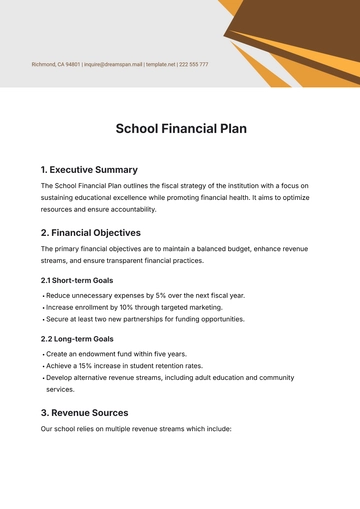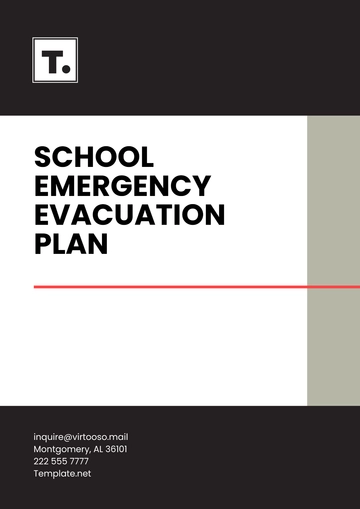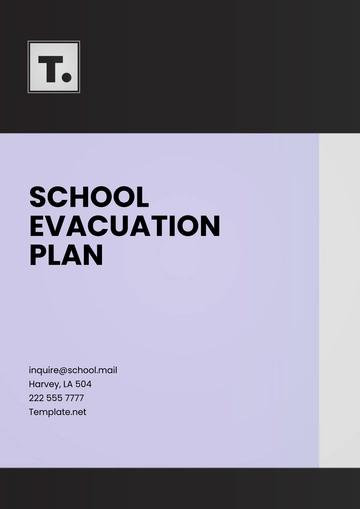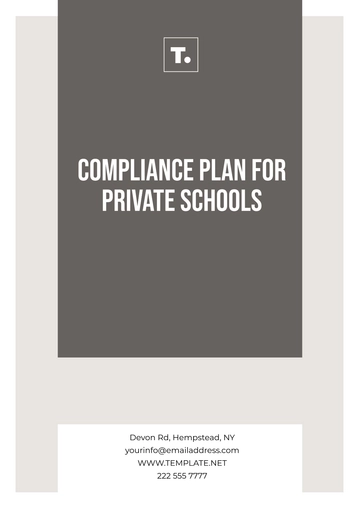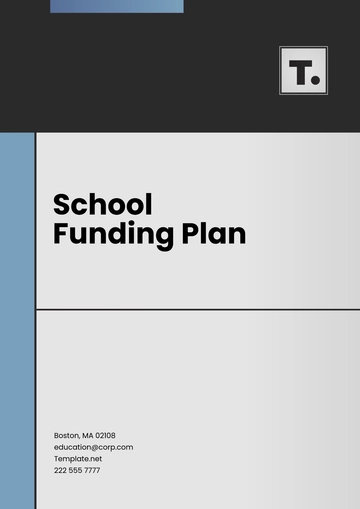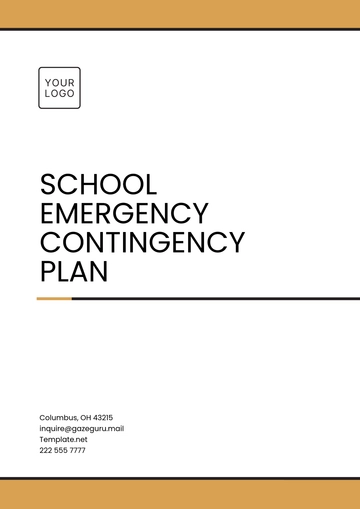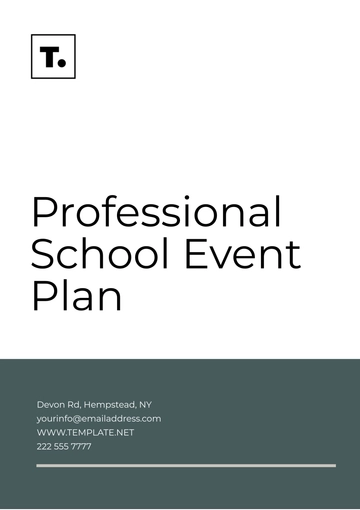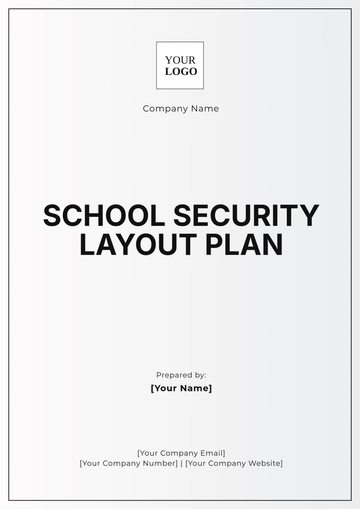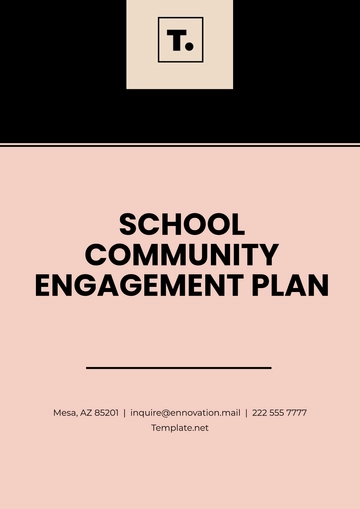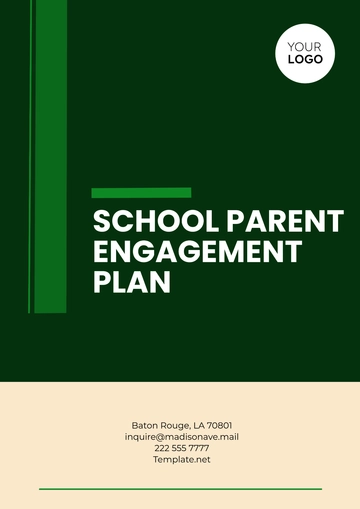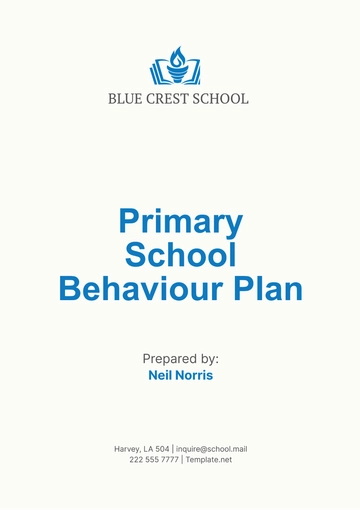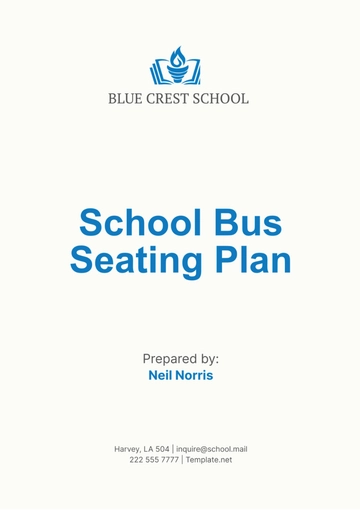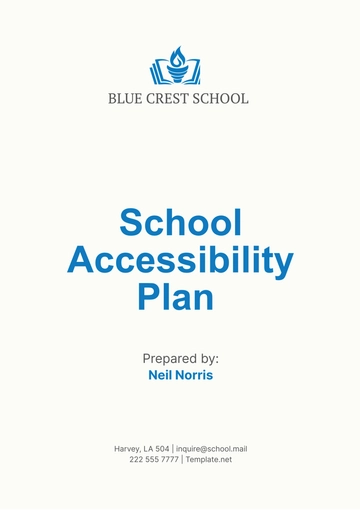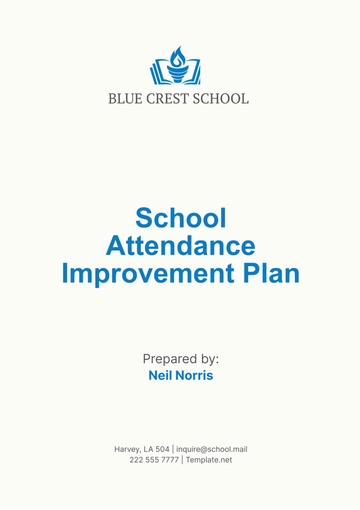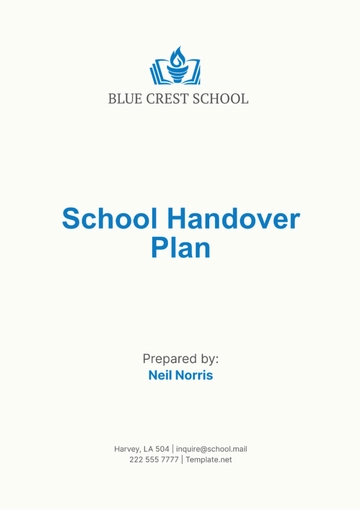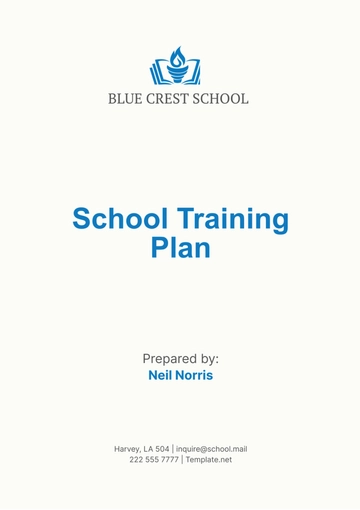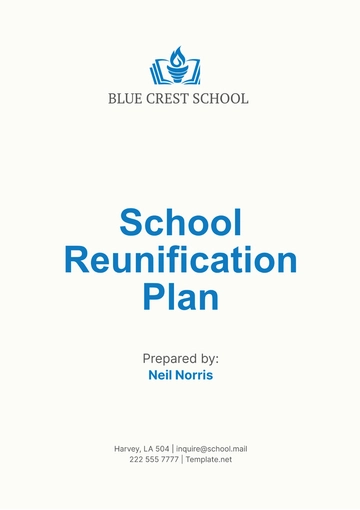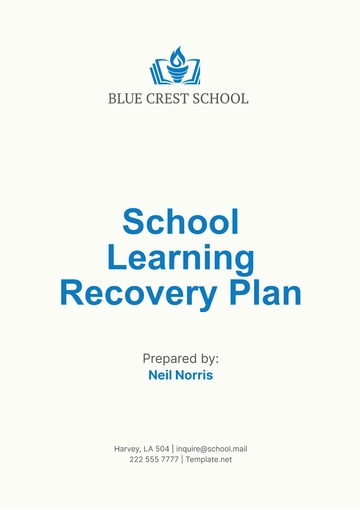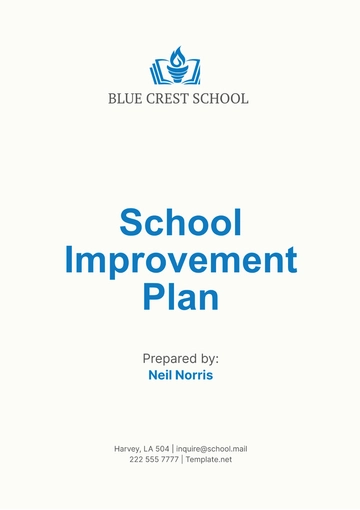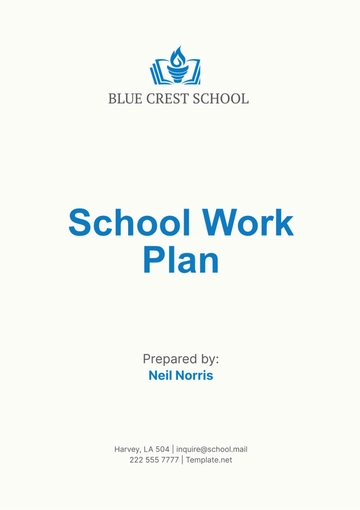Free School Management Plan

I. Introduction
This School Management Plan outlines the strategic framework for the effective management of [Your Company Name]. The plan aims to enhance educational outcomes, improve operational efficiency, and foster a supportive and dynamic learning environment. It encompasses all aspects of school operations, including administration, academic programs, student services, community engagement, and resource management. The goal is to provide a comprehensive and actionable guide that ensures the sustained success and growth of the school.
II. Vision and Mission
Vision
To be a leading educational institution recognized for excellence in teaching, innovation, and community engagement, where every student is empowered to achieve their full potential.
Mission
Our mission is to provide a high-quality education that fosters academic excellence, critical thinking, and lifelong learning. We are committed to creating a nurturing and inclusive environment that supports the holistic development of our students and prepares them for future success.
III. Strategic Goals
The strategic goals of [Your Company Name] are designed to guide the school's development and ensure alignment with our vision and mission. These goals focus on academic excellence, operational efficiency, community engagement, and continuous improvement.
A. Academic Excellence
Enhance Curriculum Delivery: Integrate advanced teaching methodologies and technology to improve the delivery of the curriculum.
Boost Student Performance: Increase student performance in standardized tests and internal assessments through targeted interventions and support.
Expand Academic Programs: Introduce new elective courses and advanced placement (AP) programs to provide diverse learning opportunities.
B. Operational Efficiency
Streamline Administrative Processes: Implement efficient administrative systems to reduce paperwork and improve workflow.
Optimize Resource Allocation: Ensure effective allocation of financial, human, and material resources to support educational goals.
Enhance Infrastructure: Upgrade facilities and technology to create a conducive learning environment.
C. Community Engagement
Strengthen Parent-Teacher Collaboration: Foster strong relationships between parents and teachers to support student learning.
Promote Community Involvement: Engage the local community through partnerships, service projects, and events.
Enhance Communication: Utilize digital tools to improve communication with all stakeholders.
D. Continuous Improvement
Professional Development: Provide ongoing training and development opportunities for teachers and staff.
Performance Evaluation: Implement a comprehensive evaluation system to assess the effectiveness of programs and initiatives.
Innovation and Research: Encourage innovative practices and research to stay at the forefront of educational trends.
IV. Administrative Structure
An effective administrative structure is essential for the smooth operation of the school. This section outlines the roles and responsibilities of key administrative positions to ensure clear lines of authority and accountability.
A. School Leadership
Principal
Responsibilities: Provide overall leadership and direction for the school, oversee academic programs, manage staff, and ensure compliance with policies and regulations.
Reporting: Reports to the school board.
Vice-Principal
Responsibilities: Assist the principal in administrative duties, oversee student discipline, manage extracurricular programs, and coordinate staff development.
Reporting: Reports to the principal.
B. Academic Departments
Department Heads
Responsibilities: Lead and manage academic departments, oversee curriculum development, support teacher performance, and ensure the implementation of best practices.
Reporting: Report to the principal.
C. Support Staff
Administrative Assistants
Responsibilities: Provide administrative support to school leadership, manage records, handle communications, and coordinate events.
Reporting: Report to the principal and vice-principal.
IT Staff
Responsibilities: Maintain and support the school's technology infrastructure, assist with the integration of technology into the classroom, and ensure data security.
Reporting: Report to the principal.
D. Committees
School Improvement Committee
Responsibilities: Develop and implement school improvement plans, monitor progress, and recommend strategies for continuous improvement.
Reporting: Reports to the principal and vice-principal.
Safety Committee
Responsibilities: Ensure a safe school environment, develop safety protocols, conduct regular safety drills, and review incident reports.
Reporting: Reports to the principal.
V. Academic Programs
The academic programs at [Your Company Name] are designed to provide a rigorous and comprehensive education that meets the needs of all students. This section outlines the core curriculum, elective courses, and special programs that support academic excellence.
A. Core Curriculum
The core curriculum includes foundational subjects that are essential for student development and academic success. These subjects are taught across all grade levels and include:
Mathematics: Emphasis on problem-solving, critical thinking, and application of mathematical concepts.
Science: Focus on inquiry-based learning, experimentation, and understanding of scientific principles.
English Language Arts: Development of reading, writing, speaking, and listening skills.
Social Studies: Exploration of history, geography, economics, and civics.
Physical Education: Promotion of physical fitness, health, and well-being.
B. Elective Courses
Elective courses provide students with opportunities to explore their interests and develop specialized skills. These courses are offered in various disciplines, including:
Arts: Courses in visual arts, music, drama, and dance.
Technology: Courses in computer science, coding, robotics, and digital media.
Languages: Courses in foreign languages such as Spanish, French, and Mandarin.
Career and Technical Education (CTE): Courses in areas such as business, health sciences, and engineering.
C. Special Programs
Special programs are designed to meet the diverse needs of students and provide additional support and enrichment. These programs include:
Advanced Placement (AP): College-level courses that prepare students for AP exams and earn college credit.
Special Education: Services and support for students with disabilities, including individualized education plans (IEPs).
Gifted and Talented: Programs for students identified as gifted or talented, offering advanced coursework and enrichment activities.
English Language Learners (ELL): Support for students whose first language is not English, focusing on language acquisition and academic integration.
VI. Student Services
Student services are critical to supporting the holistic development of students and ensuring their well-being. This section outlines the various services provided to students at [Your Company Name].
A. Counseling Services
Counseling services are provided to support the emotional, social, and academic needs of students. These services include:
Individual Counseling: One-on-one sessions with a school counselor to address personal issues, academic concerns, and career planning.
Group Counseling: Group sessions focused on common issues such as stress management, peer relationships, and study skills.
Crisis Intervention: Immediate support for students experiencing a crisis or emergency.
B. Health Services
Health services are provided to ensure the physical well-being of students. These services include:
Health Screenings: Regular screenings for vision, hearing, and general health.
Medical Care: On-site medical care for minor injuries and illnesses, and coordination with local healthcare providers for more serious issues.
Health Education: Programs and workshops on topics such as nutrition, exercise, and mental health.
C. Academic Support Services
Academic support services are designed to help students achieve their full academic potential. These services include:
Tutoring: After-school tutoring sessions for students who need additional academic support.
Homework Help: Assistance with homework assignments and study skills.
Study Groups: Organized study groups for peer support and collaborative learning.
D. Extracurricular Activities
Extracurricular activities provide students with opportunities to develop their interests and talents outside the classroom. These activities include:
Sports Teams: Competitive sports teams in various disciplines such as basketball, soccer, and swimming.
Clubs and Societies: Student-led clubs and societies focused on a wide range of interests, including debate, robotics, and the arts.
Community Service: Opportunities for students to engage in community service projects and volunteer work.
VII. Community Engagement
Community engagement is essential for building strong relationships between the school and its surrounding community. This section outlines the strategies and initiatives to foster community involvement at [Your Company Name].
A. Parent Engagement
Parent-Teacher Associations (PTA)
Objective: Foster collaboration between parents and teachers to support student learning and school improvement.
Activities: Organize meetings, events, and fundraising activities.
Parent Workshops
Objective: Provide parents with the knowledge and skills to support their child's education.
Activities: Conduct workshops on topics such as homework help, digital safety, and positive parenting.
B. Community Partnerships
Local Business Collaborations
Objective: Partner with local businesses to provide students with internship opportunities and real-world experience.
Activities: Develop internship programs, guest lectures, and sponsorships for school events.
Non-Profit Organizations
Objective: Collaborate with non-profit organizations to support community service initiatives and provide resources for students.
Activities: Organize community service projects, volunteer opportunities, and resource drives.
C. Community Events
School Open Houses
Objective: Showcase the school's programs, facilities, and achievements to the community.
Activities: Host open houses, tours, and informational sessions.
Cultural Celebrations
Objective: Celebrate the diversity of the school community and promote cultural understanding.
Activities: Organize cultural festivals, performances, and exhibitions.
VIII. Resource Management
Effective resource management is crucial for the sustainable operation of the school. This section outlines the strategies for managing financial, human, and material resources at [Your Company Name].
A. Financial Management
Budget Planning
Objective: Develop a comprehensive budget that aligns with the school's strategic goals.
Activities: Conduct budget planning sessions, allocate funds to priority areas, and monitor expenditures.
Fundraising
Objective: Secure additional funding to support school programs and initiatives.
Activities: Organize fundraising events, apply for grants, and seek donations from the community.
B. Human Resource Management
Staff Recruitment and Retention
Objective: Attract and retain high-quality staff to support the school's educational goals.
Activities: Implement effective recruitment strategies, provide competitive salaries and benefits, and create a positive work environment.
Professional Development
Objective: Provide ongoing training and development opportunities for staff to enhance their skills and knowledge.
Activities: Organize professional development workshops, offer online courses, and support attendance at conferences.
C. Material Resource Management
Facility Maintenance
Objective: Ensure that the school's facilities are safe, clean, and conducive to learning.
Activities: Conduct regular maintenance checks, repair and upgrade facilities, and manage cleaning services.
Technology Management
Objective: Maintain and support the school's technology infrastructure to enhance teaching and learning.
Activities: Upgrade hardware and software, provide technical support, and ensure data security.
IX. Evaluation and Improvement
Continuous evaluation and improvement are essential for the success of the school. This section outlines the evaluation methods and strategies for ongoing improvement at [Your Company Name].
A. Evaluation Methods
Performance Metrics
Objective: Measure the effectiveness of programs and initiatives.
Activities: Develop and monitor key performance indicators (KPIs), conduct surveys, and analyze data.
Stakeholder Feedback
Objective: Gather feedback from students, parents, staff, and community members to inform decision-making.
Activities: Conduct surveys, focus groups, and public forums.
B. Continuous Improvement Strategies
Action Plans
Objective: Develop and implement action plans to address identified areas for improvement.
Activities: Set goals, assign responsibilities, and monitor progress.
Innovation and Research
Objective: Encourage innovative practices and research to stay at the forefront of educational trends.
Activities: Support pilot projects, collaborate with educational researchers, and participate in professional networks.
X. Conclusion
The School Management Plan for [Your Company Name] provides a comprehensive framework for achieving our strategic goals and ensuring the sustained success of our school. By focusing on academic excellence, operational efficiency, community engagement, and continuous improvement, we are committed to providing a high-quality education that prepares our students for future success. We look forward to the successful implementation of this plan and the positive impact it will have on our school community.
- 100% Customizable, free editor
- Access 1 Million+ Templates, photo’s & graphics
- Download or share as a template
- Click and replace photos, graphics, text, backgrounds
- Resize, crop, AI write & more
- Access advanced editor
Elevate your school's organizational efficiency with Template.net's School Management Plan Template. Seamlessly coordinate administrative tasks, academic schedules, and staff responsibilities. Editable and customizable with our AI editor tool, this template offers a streamlined solution for managing day-to-day operations and fostering a conducive learning environment.
You may also like
- Finance Plan
- Construction Plan
- Sales Plan
- Development Plan
- Career Plan
- Budget Plan
- HR Plan
- Education Plan
- Transition Plan
- Work Plan
- Training Plan
- Communication Plan
- Operation Plan
- Health And Safety Plan
- Strategy Plan
- Professional Development Plan
- Advertising Plan
- Risk Management Plan
- Restaurant Plan
- School Plan
- Nursing Home Patient Care Plan
- Nursing Care Plan
- Plan Event
- Startup Plan
- Social Media Plan
- Staffing Plan
- Annual Plan
- Content Plan
- Payment Plan
- Implementation Plan
- Hotel Plan
- Workout Plan
- Accounting Plan
- Campaign Plan
- Essay Plan
- 30 60 90 Day Plan
- Research Plan
- Recruitment Plan
- 90 Day Plan
- Quarterly Plan
- Emergency Plan
- 5 Year Plan
- Gym Plan
- Personal Plan
- IT and Software Plan
- Treatment Plan
- Real Estate Plan
- Law Firm Plan
- Healthcare Plan
- Improvement Plan
- Media Plan
- 5 Year Business Plan
- Learning Plan
- Marketing Campaign Plan
- Travel Agency Plan
- Cleaning Services Plan
- Interior Design Plan
- Performance Plan
- PR Plan
- Birth Plan
- Life Plan
- SEO Plan
- Disaster Recovery Plan
- Continuity Plan
- Launch Plan
- Legal Plan
- Behavior Plan
- Performance Improvement Plan
- Salon Plan
- Security Plan
- Security Management Plan
- Employee Development Plan
- Quality Plan
- Service Improvement Plan
- Growth Plan
- Incident Response Plan
- Basketball Plan
- Emergency Action Plan
- Product Launch Plan
- Spa Plan
- Employee Training Plan
- Data Analysis Plan
- Employee Action Plan
- Territory Plan
- Audit Plan
- Classroom Plan
- Activity Plan
- Parenting Plan
- Care Plan
- Project Execution Plan
- Exercise Plan
- Internship Plan
- Software Development Plan
- Continuous Improvement Plan
- Leave Plan
- 90 Day Sales Plan
- Advertising Agency Plan
- Employee Transition Plan
- Smart Action Plan
- Workplace Safety Plan
- Behavior Change Plan
- Contingency Plan
- Continuity of Operations Plan
- Health Plan
- Quality Control Plan
- Self Plan
- Sports Development Plan
- Change Management Plan
- Ecommerce Plan
- Personal Financial Plan
- Process Improvement Plan
- 30-60-90 Day Sales Plan
- Crisis Management Plan
- Engagement Plan
- Execution Plan
- Pandemic Plan
- Quality Assurance Plan
- Service Continuity Plan
- Agile Project Plan
- Fundraising Plan
- Job Transition Plan
- Asset Maintenance Plan
- Maintenance Plan
- Software Test Plan
- Staff Training and Development Plan
- 3 Year Plan
- Brand Activation Plan
- Release Plan
- Resource Plan
- Risk Mitigation Plan
- Teacher Plan
- 30 60 90 Day Plan for New Manager
- Food Safety Plan
- Food Truck Plan
- Hiring Plan
- Quality Management Plan
- Wellness Plan
- Behavior Intervention Plan
- Bonus Plan
- Investment Plan
- Maternity Leave Plan
- Pandemic Response Plan
- Succession Planning
- Coaching Plan
- Configuration Management Plan
- Remote Work Plan
- Self Care Plan
- Teaching Plan
- 100-Day Plan
- HACCP Plan
- Student Plan
- Sustainability Plan
- 30 60 90 Day Plan for Interview
- Access Plan
- Site Specific Safety Plan
